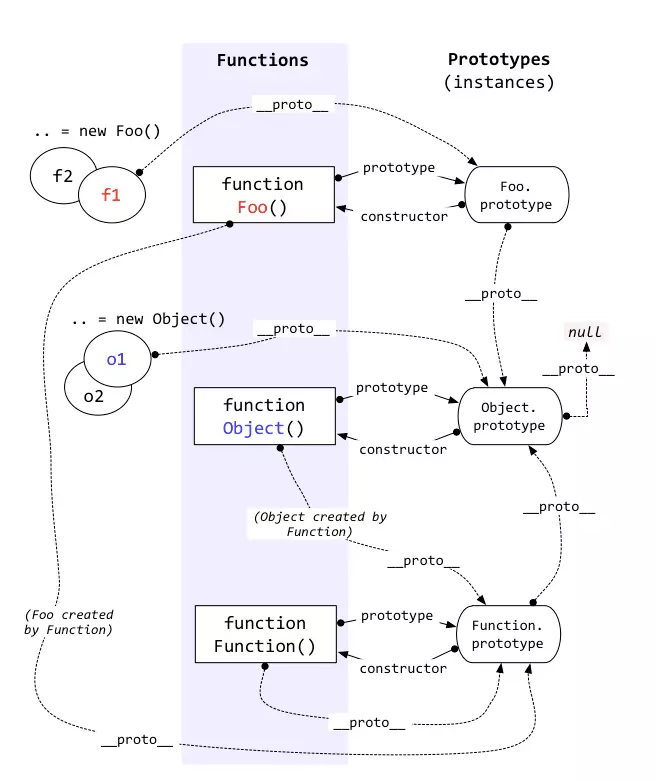Appearance
JavaScript 原型链 与 this 指向及继承
原型链
对象分为普通对象和函数对象
普通对象
普通对象:具有 __proto__ 属性并指向原型链,没有 prototype 属性。
原型对象:Foo.prototype,原型对象的 constructor 属性指向构造函数对象,构造函数对象的 prototype 属性指向原型对象。
函数对象
通过 new Function()创建的都是函数对象。有 __proto__ , prototype 属性。

this 指向
js
// 请解释最后两行函数的值为什么不一样
var obj = {
foo: function() {
console.log(this);
}
};
var bar = obj.foo;
obj.foo(); // 打印出的 this 是 obj
bar(); // 打印出的 this 是 window函数调用
js
// JS(ES5)里面有三种函数调用形式:
func(p1, p2);
obj.child.method(p1, p2);
func.call(context, p1, p2); // 先不讲 apply
// 第三种调用形式,才是正常调用形式
func.call(context, p1, p2);
// 解答
var bar = obj.foo;
obj.foo(); // 转换为 obj.foo.call(obj),this 就是 obj
bar();
// 转换为 bar.call()
// 由于没有传 context
// 所以 this 就是 undefined
// 最后浏览器给你一个默认的 this —— window 对象继承
继承的本质就是原型链
- 借助构造函数实现继承
js
/**
* 借助构造函数实现继承 -- 缺点:只能继承父类的实例属性和方法,不能继承原型属性/方法
*/
function Parent1() {
this.name = "parent1";
}
Parent1.prototype.say = function() {};
function Child1() {
Parent1.call(this);
this.type = "child1";
}
console.log(new Child1()); // without say()- 借助原型链实现继承
js
/**
* 借助原型链实现继承 -- 缺点:新增一个值 ,其他实例也跟着改变
*/
function Parent2() {
this.name = "parent2";
this.play = [1, 2, 3];
}
function Child2() {
this.type = "child2";
}
Child2.prototype = new Parent2();
console.log(new Child2());
var s1 = new Child2();
var s2 = new Child2();
s1.play.push(4);
console.log(s1.play, s2.play); // (4) [1, 2, 3, 4] (4) [1, 2, 3, 4]- 组合方式实现继承
js
/**
* 组合方式实现继承
*
* 将 1 和 2 两种方式组合起来,就可以解决1和2存在问题,这种方式为组合继承。
* 缺点:实例一个对象的时,父类 new 了两次,
* 第一次是 var s3 = new Child3()
* 第二次是 Child3.prototype = new Parent3()
*/
function Parent3() {
this.name = "parent3";
this.play = [1, 2, 3];
}
Parent3.prototype.say = function() {};
function Child3() {
Parent3.call(this);
this.type = "child3";
}
Child3.prototype = new Parent3();
var s3 = new Child3();
var s4 = new Child3();
s3.play.push(4);
console.log(new Child3());
console.log(s3.play, s4.play); // (4) [1, 2, 3, 4] (3) [1, 2, 3]- 组合继承的优化 1
js
/**
* 组合继承的优化 1
*
* 优化点: Child4.prototype = Parent4.prototype,
* 通过构造函数就可以拿到所有属性和实例的方法,
* 现在我想继承父类的原型对象,所以你直接赋值给我就行,
* 不用在去 new 一次父类。其实这种方法还是有问题的
*
* 缺点:没有办法区分一个对象是直接由它的子类实例化还是父类实例化
*/
function Parent4() {
this.name = "parent4";
this.play = [1, 2, 3];
}
Parent4.prototype.say = function() {};
function Child4() {
Parent4.call(this);
this.type = "child4";
}
Child4.prototype = Parent4.prototype;
var s5 = new Child4();
var s6 = new Child4();
s5.play.push(4);
console.log(new Child4());
console.log(s5.play, s6.play); // (4) [1, 2, 3, 4] (3) [1, 2, 3]
// 问题点
s5 instanceof Child4; // true
s5 instanceof Parent4; // true
Child4.prototype.constructor
// ƒ Parent4() {
// this.name = "parent4";
// this.play = [1, 2, 3];
// }- 组合继承的优化 2
js
/**
* 组合继承的优化2
*
* 缺点:子类没有定义自己的constructor
*
* 主要使用Object.create(),它的作用是将对象继承到__proto__属性上,
* 举例子:
var test = Object.create({ x: 123, y: 345 });
console.log(test); // {}
console.log(test.x); // 123
console.log(test.__proto__.x); // 3
console.log(test.__proto__.x === test.x); // true
*/
function Parent5() {
this.name = "parent5";
this.play = [1, 2, 3];
}
Parent5.prototype.say = function() {};
function Child5() {
Parent5.call(this);
this.type = "child5";
}
Child5.prototype = Object.create(Parent5.prototype);最后要定义子类自己的
constructor
js
/**
* JS继承最终版本
*/
function Parent5() {
this.name = "parent5";
this.play = [1, 2, 3];
}
Parent5.prototype.say = function() {};
function Child5() {
Parent5.call(this);
this.type = "child5";
}
Child5.prototype = Object.create(Parent5.prototype);
Child5.prototype.constructor = Child5;